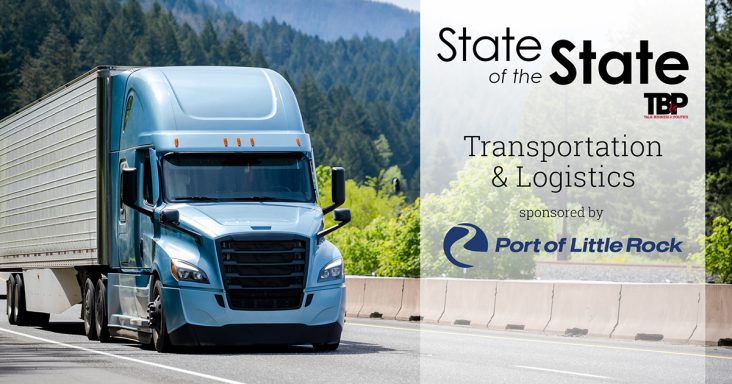State of the State 2023: Trucking industry braces for easing demand, recession
by January 24, 2023 12:11 pm 5,296 views

The trucking industry overcame multiple challenges in 2022, including some surprises, as the industry shifted from the COVID-19 pandemic into something more normal. With 2022 in the rearview, 2023 brings uncertainty and rising recession risk.
Shannon Newton, president of the Arkansas Trucking Association, said 2023 is not expected to be as healthy financially as 2022, especially in the first half of 2023. She’s hopeful the softer demand will begin to return to more normal levels and leads to growth opportunities by the end of the year.
“There’s a healthy amount of uncertainty,” said Newton, noting the economic forecasters who are predicting a recession in 2023. “Whether it is deep or wide or short or long, I think the opinions vary. But I think the industry expects there to be a recession of some sort in the early part of 2023.”
Still, she said the industry likely is “more right-sized” than ever after a period of high freight demand. Carriers typically increase capacity during these periods, but the shortages of equipment and drivers affected carriers’ ability to do so.
“There is not a lot of slack in the system,” Newton said. “We have as many drivers and trucks as we could get, which was not enough to service the demand. This was why you saw the dramatic price increases and the hefty margins that the companies were able to obtain over the last 24 months. I do think that will mute the impact that we’ve seen downturns take in the past for our industry.”
Joe Jaska, executive vice president and head of land region, Americas, at DB Schenker, said he expects the first half of 2023 to be challenging “from a volume standpoint, a rate standpoint” compared to the past two years. He said he believes the second half of 2023 to be “much more normal” and in line with historical trends, with inventory levels moderating and freight demand accelerating. DB Schenker is the German company that acquired Van Buren-based USA Truck in 2022.

In 2022, Jaska said the industry’s highlights came in the first half of the year as part of a favorable cycle for carriers that started in mid-2020. The U.S. freight market softened in the second half of 2022 amid high inventory levels and air and ocean carrier shipments returning to pre-pandemic levels. Jaska said the biggest surprise last year was how quickly the market shifted from strong to soft demand.
“It happened pretty abruptly at the end of Q2,” he said. “By the end of Q3 – 90 days – it was a vast difference in what the market looked like.”
The industry faced multiple challenges, including rising fuel prices, inflation and shortages of drivers, trucks and parts, said Newton, adding that the high fuel costs and parts shortage were unexpected. In October, the American Transportation Research Institute, the industry’s nonprofit research organization, released the top industry issues report that showed fuel prices as the No. 1 issue, eclipsing the driver shortage. Fuel prices previously made the top 10 list in 2013 at No. 8.

“I think we pierced the highest fuel price on record a couple of times in 2022,” Newton said. “The dramatic nature that it was so extensive and also the fact there was very little lead time to know that was coming made it a pretty big impact on carriers of all sizes.”
Also, she said carriers did not foresee how significantly the parts shortage would impact them in 2022 and that it affected carriers’ ability to maintain their equipment. With the limited availability of new trucks, fleets were operating older equipment longer, requiring additional maintenance.
“What used to be down 12 hours to replace a part — now we had trucks that were down weeks, waiting on parts that they couldn’t get,” she said. “That was another thing the industry hasn’t experienced before: a parts shortage that was so debilitating it was putting trucks out of service. It had an impact on capacity. It had an impact on profitability.”
Jaska said controlling rising costs, such as fuel, equipment and insurance expenses, has been a significant challenge. He highlighted the importance of relationships with vendors and manufacturers and involvement in trade groups to ensure legislators understand industry concerns. He added that the most successful carriers will be those that can retain their drivers.
“All the things we do in terms of culture within our company to make sure the drivers are viewed and feel as though they’re important parts of the team and that they’re valued,” he said. “The biggest challenge is making a work-life balance something acceptable that a driver is going to be able to experience when they have a company.”
Newton said workforce shortages have been challenging for years. Federally, she said the driver apprenticeship pilot program for 18- to 20-year-olds has been important in addressing the issue. Also significant, she said, is ensuring that driver training programs receive equal funding compared to other career education programs and that prospective drivers and technicians have the same access to grants and scholarships as those entering other fields.
According to the American Trucking Associations, the industry has 3.5 million drivers and is short about 80,000 nationwide. Based on this, the Arkansas shortage is about 900 drivers, but this might be a conservative estimate, with the industry employing one in 10 Arkansans.
Editor’s note: The State of the State series provides reports twice a year on Arkansas’ key economic sectors. The series publishes stories to begin a year and stories in July/August to provide a broad mid-year update on the state’s economy. Link here for the State of the State page and previous stories.
